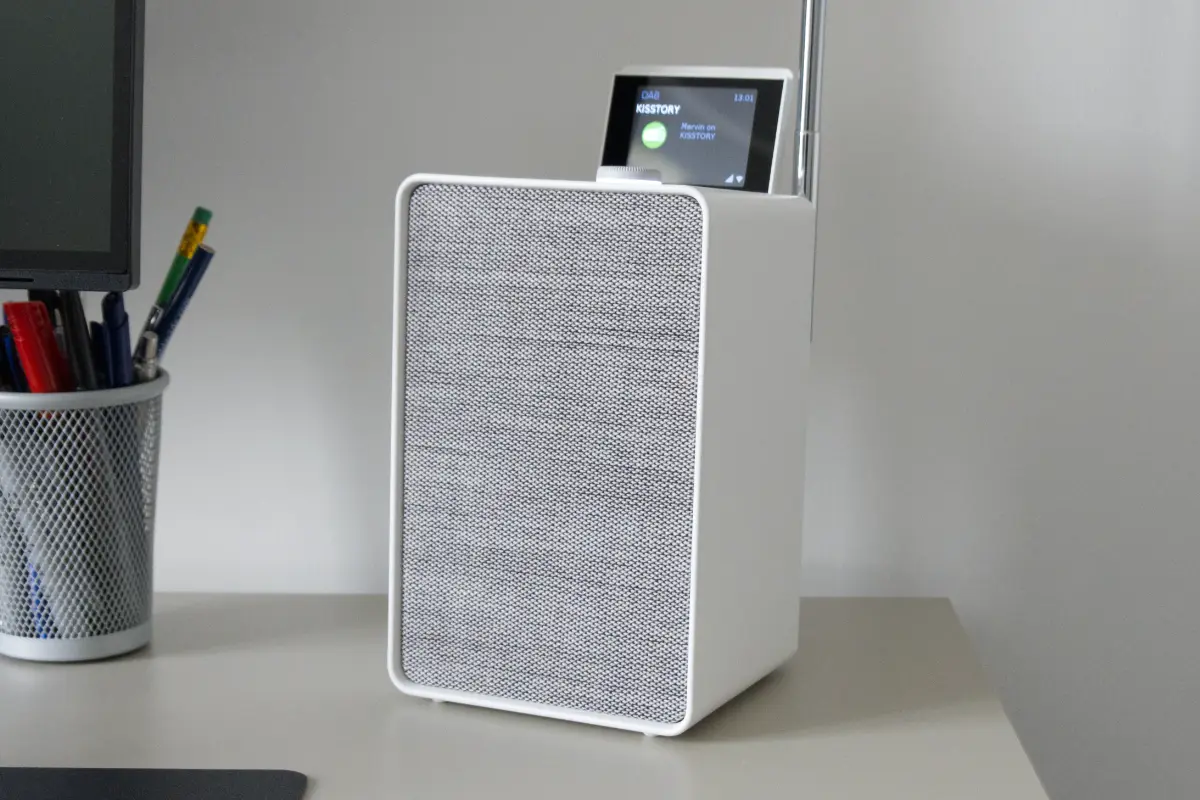The Pure Evoke Spot is a DAB/DAB+/FM digital and Internet radio with Bluetooth. Pure pitches the Evoke Spot, the smallest of the three devices in the current Evoke family, as a compact music system for the kitchen, home office or bathroom.
As well as DAB/DAB+ and FM radio the Evoke Spot receives over 85,000 Internet radio stations and podcasts over Wi-Fi. Spotify Connect is included for users of the streaming service and Bluetooth allows for streaming from other music and podcast apps.
The radio in our review is the Cotton White colour option with the fabric speaker grille. There’s also Coffee Black with a fabric speaker grille and Pure recently introduced models with a cherry wood grille.
Setting up the radio
Unboxing and plugging in the radio is quick and easy. The box has a premium feel and the power adapter and literature are included in a smaller cardboard box.
When switched on for the first time the radio launches a setup wizard which mainly deals with the time and network connection. We opted to press the WPS button on our WiFi router to set up the wireless connection and were ready to choose a source after a few seconds.
For DAB/DAB+ and FM radio stations a telescopic antenna is included on the back of the radio. This could be left folded away if those modes won’t be used. The antenna is not removable.
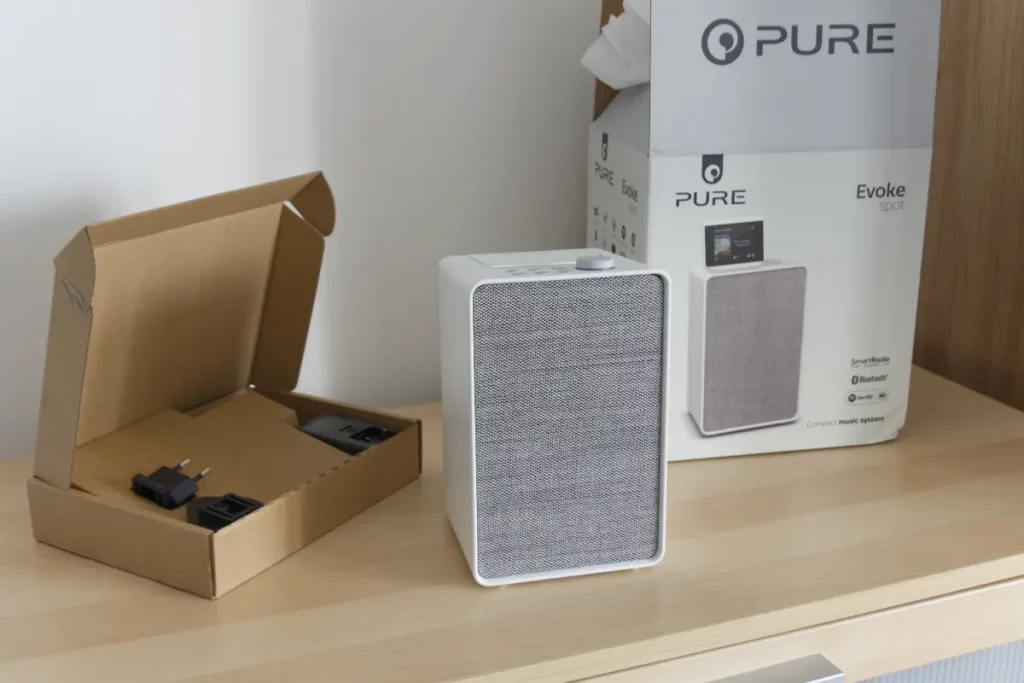
A power adapter is included with the radio. There are no options to power the radio from batteries and only the bigger Evoke Play is compatible with an optional battery pack. The omission of a carry handle does underline that this is a music system destined for bookshelves rather than a portable radio.
We found the quick start guide a little difficult to follow with space taken up by many languages for each option. The guide also doesn’t seem to indicate when a button should be pressed normally or held down with a long press. The PDF manual does make that distinction and we found it a bit easier to navigate. However, it does cover all three models in the range with distinctions made where operations differ. The manual being split into different languages helped make it easier to use, but space is taken up by references to aux-in and the CD functions which our Spot doesn’t have.
The warranty isn’t mentioned on the Pure website, but Hughes offer a 3 year guarantee with the radio and John Lewis & Partners have a 2 year guarantee included.
The Evoke Spot is the smallest in the Evoke range, below the Play and Home. The Play boasts two tweeters and a woofer with 40W output power, while the Home adds a CD player and takes the output up to 100W. On initial impressions we wouldn’t be tempted by those if the main consideration is a smart radio that’s suitable for a kitchen or study.
Sound quality with the Evoke Spot
Sound comes from a single 3” full-range speaker on the front of the radio. A bass reflex port is also provided to help boost the bass output. Pure lists the power output as 20W in the specifications.
To find a sound that’s more suited to personal tastes the bass and treble can be customised. In the menu, under Equaliser, the My EQ profile setup provides options to increase and decrease bass and treble by plus and minus 7. We’ve previously tweaked these settings on another Pure radio and a small adjustment gave us a sound we slightly preferred.
This was the case again with the Pure Evoke Spot which we initially felt provided too much bass and was a little distracting on a desk even at low volumes. Reducing the bass and increasing the treble did help slightly and further tweaking over the next few days helped us arrive at a good balance.
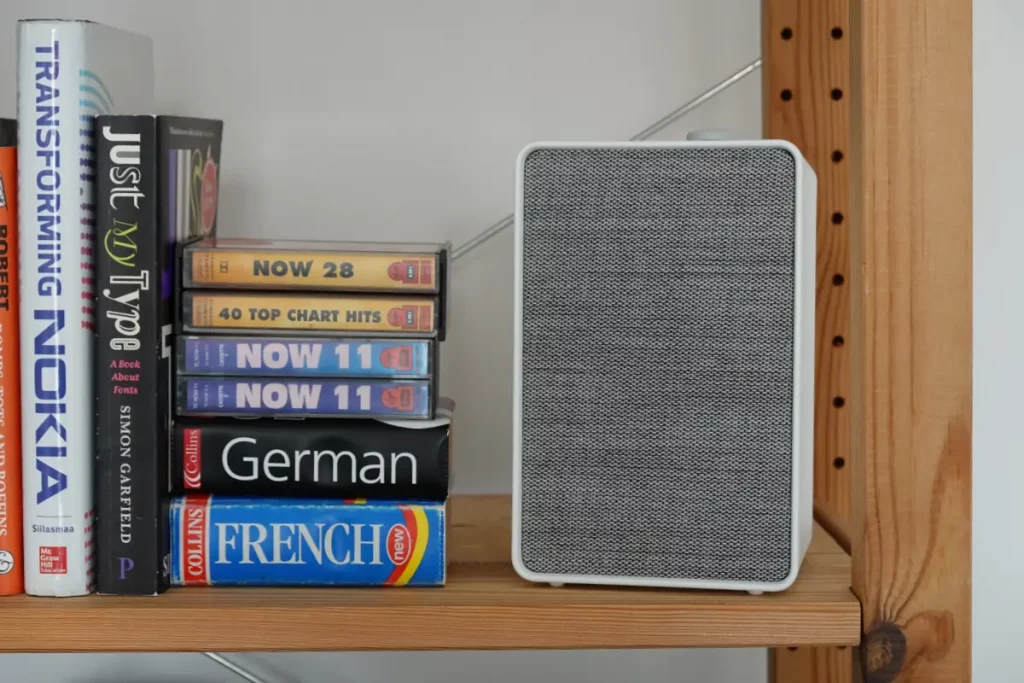
Radio stations on DAB digital radio sound good but we wish there was a little more clarity and definition to the sound. The radio may be doing what it can with radio stations broadcasting in lower bitrates and switching over to the Internet radio mode things do improve. Playing FLAC files from a smartphone in the Bluetooth mode we found ourselves turning down the bass again. Listening to The Heinrich Maneuver by Interpol and LUNCH by Billie Eilish it felt at times as if bass and vocals had priority over other sounds.
In a study the volume range proves to be useful. For quiet background music and speech the lowest volume settings are fine while at half way the volume is more than enough for a study or even a small kitchen. As there is a sleep timer it would have been nice if the lowest volume setting was slightly quieter and just audible for bedside listening.
There’s no headphone output on the Pure Evoke Spot. A 3.5mm headphone socket is provided on the bigger brother Evoke Home, but there are no ways to listen privately on the Evoke Spot.
Using the Pure Evoke Spot
Controls are found on the top of the radio. An intriguing feature is the foldaway display which contributes to the clean design and hides some of the buttons when the display is down. These two areas of controls are referred to by the manual as the Preset Area and Display Area.
The main on/off, volume control and play/pause knob is always available on the top of the radio, as are four preset buttons and back and forwards buttons for changing music and radio stations.
Buttons in the Display Area control the source, Bluetooth, favourites/presets, menu navigation and info display. The control with up/down/left/right directions and a centre select button is used to navigate the lists of Internet radio stations and podcasts.
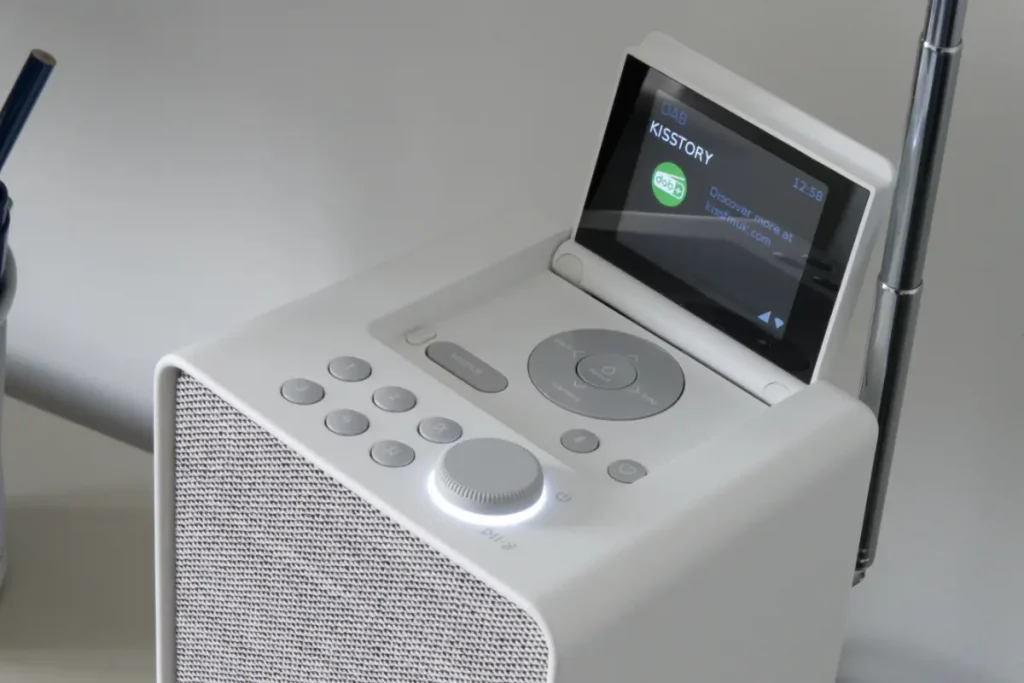
All of the controls feel good and are a pleasure to use. Button presses are not too spongy or clicky and the volume control gives good feedback as it turns through each level. The display opens and closes with a slightly resistive feeling somewhat like a laptop screen.
The display is bright and easy to read. In the standby mode the time and date are shown and the interface will feel familiar to anyone who has used radios by Pure and some other manufacturers in recent years. We did find the text that accompanies DAB digital radio stations to scroll up the screen too slowly for our liking. A setting is included for the display brightness but we would like to have seen more distinct differences between the brightness levels.
Radio, podcasts, Bluetooth and Spotify
In the DAB+ digital radio mode we received all the stations we would expect in this area. Navigating between stations is quick and easy with a few shown at a time in the station list on the display. The same is true of the FM mode, locking on to the stations we would expect when scanning through the band. For those stations the RDS station name and radio text were quick to display.
Switching to Internet radio and we were able to find the UK and International stations we were looking for. These all started playing quickly with now playing information displayed (for stations that provide it). Browsing for stations can be cumbersome, but this is down to the software or radio directory which is common to a few Internet radios. Long lists of stations can make browsing laborious with repeated button presses to navigate through the available options. The ‘local’ list of stations seemed to focus on London and while it’s possible to browse by city, the list omits Sheffield but includes Kings Lynn.
The lists of popular stations did allow us to quickly tune in to recognisable channels from Germany and the Netherlands.
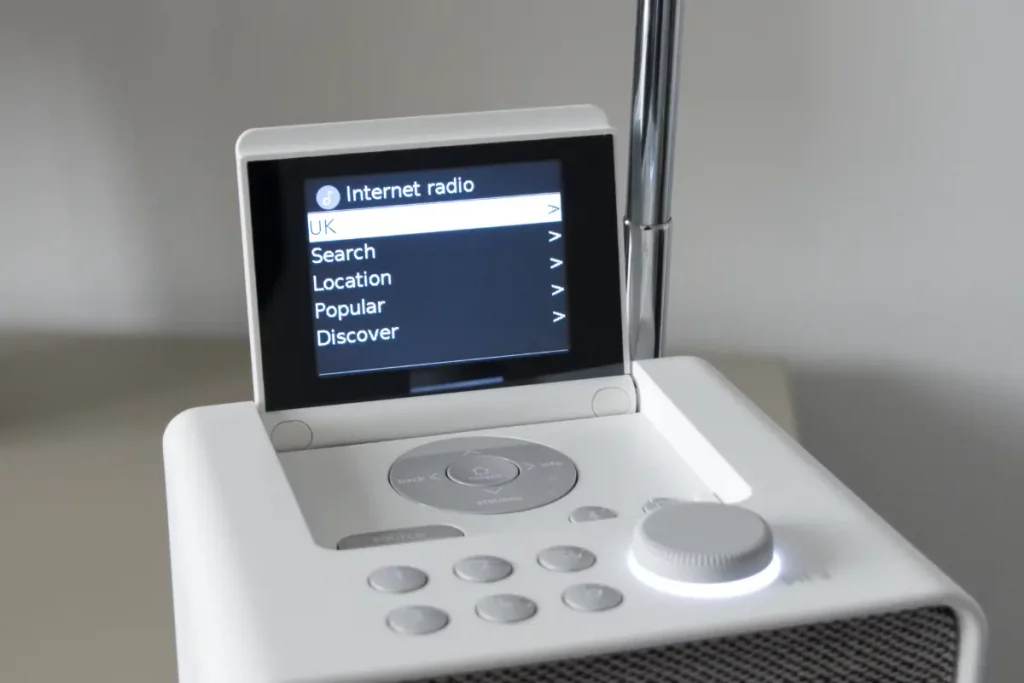
However, a hugely positive feature in our view is that custom Internet radio stations can be added to the radio through a web browser. This is useful for listening to stations that are not in the directory. Also, should the directory be deprecated in the years to come, it should be possible to add the streaming URLs manually and continue to use the Internet radio mode.
The Bluetooth mode works well with information about the current track in an app being shown on the display. The menu includes Spotify Connect for users of the streaming service.
There is a podcast mode but it may be better for casual listening rather than as a replacement for a podcast app. For example, if you wanted to put on the BBC’s Friday Night Comedy Podcast it’s easy to find and play. But the radio doesn’t remember the playback position if you come back to it after changing modes or switching off the radio. We couldn’t find a way to see information about episodes, such as dates or show notes. For listening to subscribed podcasts it might be better to use an app and Bluetooth, but if you do want to hear a podcast and don’t have a smartphone it’s certainly good enough.
Verdict
Overall we really like the Pure Evoke Spot. When many Internet radios have a cluttered front panel and shiny plastic the Evoke Spot goes the other way with a matt finish, fabric front and the option to hide away the display and most of the controls. Sound is good overall in a kitchen or study and the range of sources provides plenty of listening options.
We would have liked to see a bit more detail in the manual, especially around the Internet radio mode, its directory and adding stations. To Pure’s credit we did make a customer support enquiry and their support team responded within 24 hours with instructions and a screenshot.
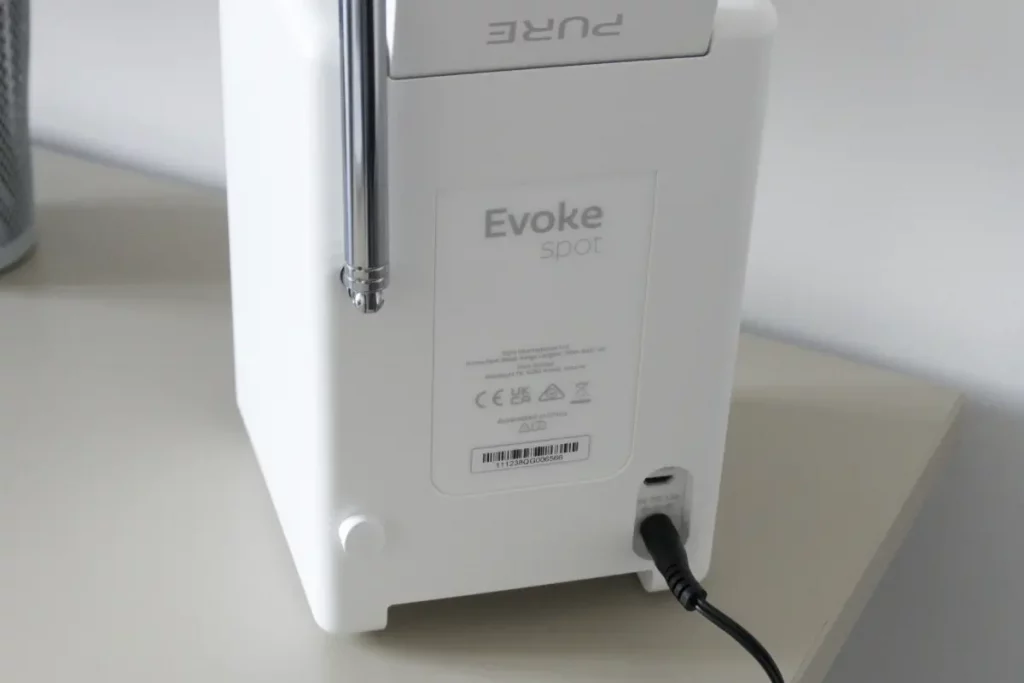
We’d have liked to have seen the option for playing music from a local network without using a smartphone or tablet and the Bluetooth mode. At a time when CD sales are increasing and there’s more interest in ‘dumb phones’ it would have been good to play our own music over WiFi.
This review was written in September 2024. The product in this review was purchased from John Lewis & Partners.
